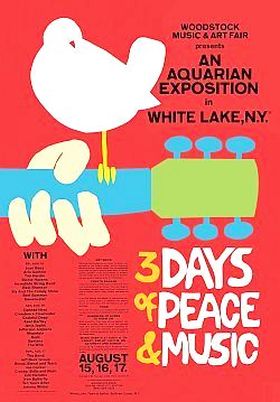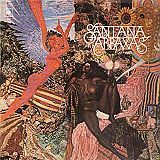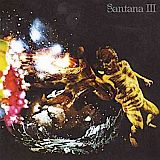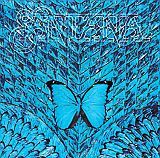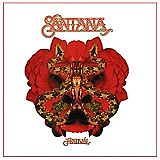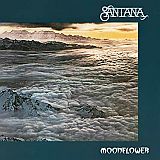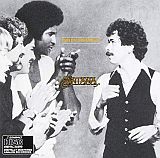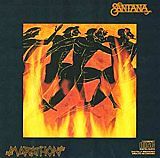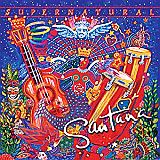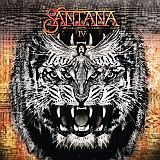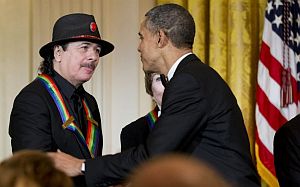Music Player
“Jingo”- Santana
The sound came rolling over the hillsides and across the pastures; some said they could feel it in the earth as they walked. One of the songs they were hearing – along with 400,000 others at Woodstock that day – was titled “Jingo” (sampled above). That song opens with congas, then builds to big drums, rising organ, piercing electric guitar, and later, some backing vocals. But at its opening, the song has something of a primitive, native sound to it – in a good, earthy way – and in fact, was an African-derived song first done in 1959 by Nigerian percussionist Babatunde Olatunji.
But that afternoon at Woodstock, “Jingo” and others were being performed by a new west coast group that most in attendance had never heard of; a group called Santana. But this “Santana sound” of hard-driving Afro-Latin instrumentals was perfect for an outdoor festival. And that afternoon, it raised the energy level of the Woodstock multitudes then covering the hillsides, setting thousands to moving, dancing, and feeling the power of that day. Neither they nor Santana would ever be quite the same again.
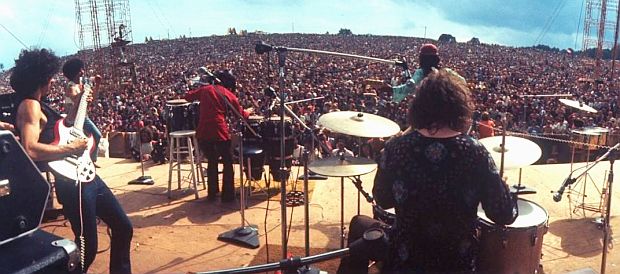
Aug 1969. Santana at Woodstock, looking out over the huge crowd – at far left front, Michael Carabello, Jose Areas on congas, David Brown on guitar, Carlos Santana, rear left, guitar, and Michael Shrieve, drums. Not shown, far left, Gregg Rolie, organ.
Santana, named after their leader, Mexican-born American guitarist, Carlos Santana, had in fact, scored their slot on the big Woodstock festival almost by accident. They weren’t on the promoters’ original “A-list” of big, “have-to-get” rock stars. In fact, they were pretty much an unknown entity nationally, except for their west coast and San Francisco exposure. Some on the east coast had heard them a few weeks earlier at the Atlantic City Pop Festival of August 1-3, 1969. A mere 100,000 attended that gathering, some of whom were impressed by Santana’s performance there. Still, Santana had not yet cut an album and were unknown by most.

August 16, 1969. Carlos Santana, Jose Areas, and Michael Carabello during performance at Woodstock.
In the 1960s, Santana and his band had more or less broken into the San Francisco music scene by way of promoter Bill Graham, famous for his Fillmore ballroom, a performance venue where a number of rock acts were given exposure that helped launch their careers – notably The Grateful Dead, Jefferson Airplane, and others. Graham also booked acts at a second San Francisco venue, Winterland, as well as the Fillmore East in New York city. Graham’s venues in the 1968-1971 period were places where performers could experiment and improvise, engage in long sets, and where fans felt comfortable and could even dance in the aisles if they chose.
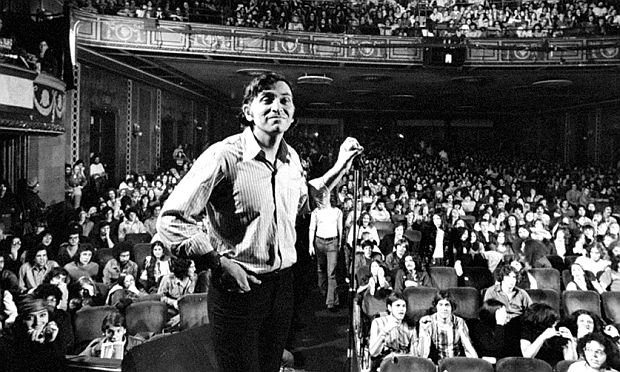
Famous music promoter, Bill Graham, shown here at his Fillmore East venue in New York City, 1971. Photo, John Olson/ Life.
Carlos Santana had played music with his father as a youth, but it was not his style of music. By 1961, the Santana family had moved to San Francisco, and Carlos worked for a time as a dishwasher while pursuing his music. Bill Graham had taken an interest in the young Mexican-American guitarist, a kid he’d first met trying to sneak into the Fillmore. Santana’s band formed in 1966, initially as the Santana Blues Band with the help of guitarist Tom Fraser. Santana’s group made their debut at the Fillmore in 1968 and were soon managed by Graham, who sensed their sound was different and had potential. By 1969 the band consisted of Santana on lead guitar, Gregg Rolie on organ and keyboards, David Brown on bass, Michael Shrieve on drums, and Michael Carabello and Jose Areas, both on congas and percussion.
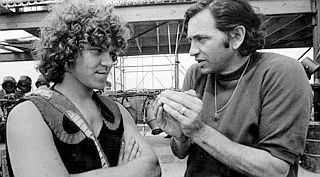
1969: Bill Graham, right, at Woodstock with promoter Michael Lang, likely discussing some aspect of Woodstock's logistics.
Graham believed that Woodstock could be a big breakout moment for Santana, and told them so one evening when he assembled the group at his home in Mill Valley outside of San Francisco. He told them this was their big chance, and if done well, they would emerge on a par with the biggest names in rock. Yet they were skeptical, as Carlos Santana would recall saying, “Bill, we’re from the Mission. We don’t buy into that rock star thing.” The group had no track record beyond their west coast performances. Although in May 1969, they had gone into the studio to record some of their music for a possible later album release.
At Woodstock, Santana and band arrived on Saturday morning, August 16th, for the festival’s second day of music. They were under the impression they would not go on until much later that night, closer to midnight. But in the early afternoon, at around 2:00 pm, they were suddenly rushed on stage, told it was now or never. They performed a 45-minute set of eight songs, of which “Soul Sacrifice” — near the end of their set and including a famous drum solo by Michael Shrieve — was one of the big hits of the festival.
The Santana performance at Woodstock left a lasting impression on many who experienced it live that August afternoon in 1969. One college student who attended Woodstock with a group of friends, later posted comments noting: “…From a musical standpoint, Santana was unforgettable…. They had the entire crowd on it’s feet and dancing. I believe that this event really launched them to a national level….” Another noted “Santana’s near shamanic outpouring of exuberance on ‘Soul Sacrifice’”. Michael Spendolini, in later comments to the New York Times recalling his visit to Woodstock with a group of guys who piled into a VW bug from Connecticut, noted: “A couple of us were active musicians playing in bands for local high school and college dances…. and were thinking we were ‘aware’ of the music scene until we heard Santana. We, like everyone else there, were totally taken by the sound and ethnic vibe of this unique sound. The crowd reacted immediately and I would say that the energy level of the crowd at that time of day was at its peak.”

Santana's first album, released a few weeks after Woodstock, rose to No. 4 on the Billboard album chart, and would remain on that chart for two years. Includes “Jingo,” “Soul Sacrifice” & “Evil Ways”. Click for CD.
Their debut album, Santana, which had been recorded in May 1969, was released two weeks after Woodstock, on August 30, 1969. It quickly peaked at No. 4 on the Billboard 200 albums chart and would stay on that chart for two years. In 2003, Rolling Stone magazine ranked the Santana album at No. 150 on their list of the 500 greatest albums of all time.
Composed mostly of instrumental tracks, the album contains their first two singles, “Jingo” and “Evil Ways”. The latter became a Top Ten hit, rising to No. 9 on the Billboard Hot 100. The album would later reach 2x-Platinum in sales and be reissued in 1998 and 2004.
But in the aftermath of Woodstock, the market momentum for Santana and other festival performers would continue for some time following the event, as both a film on Woodstock and an album of its music – the first of many – would follow.
Film & Music

The Woodstock film was first released for theaters in 1970, followed by an expanded director’s cut in 1994, and a second expanded version for a 40th anniversary edition in 2009, shown here. Click for DVD.
In May of 1970, a live album of selected performances from the 1969 Woodstock festival was released under the title, Woodstock: Music from the Original Soundtrack and More. It was originally released on Atlantic Records’ Cotillion label as a triple album, and also included Santana’s “Soul Sacrifice” among its selections. All of the Woodstock “media” and music items that followed the festival helped raise the stock and trade of Santana and other acts who had appeared there.
Santana Gigs
Santana, meanwhile, through the remainder of 1969 and 1970, became a sought-after act at numerous venues beyond those in California where they had been appearing prior to Woodstock. Over the next year, between August 18, 1969, beginning at the Electric Factory in Philadelphia, Pennsylvania, and ending on June 28, 1970 in England at the Bath Festival of Blues and Progressive Music, Santana appeared at more than 70 locations across the U.S. and Europe. They were performing somewhere almost daily during that time. Included in their 1969-1970 touring were several large festivals, such as the Texas International Pop Festival at the Dallas International Motor Speedway on August 31, 1969 and the Altamont Speedway Free Festival of December 6, 1969 at Tracy, California. They also appeared on the Ed Sullivan Show on October 24, 1969 in New York City. Bill Graham, meanwhile, would feature Santana, among other acts, at his various venues in San Francisco and New York city during this time.
Albums
Carlos Santana and the Santana band would continue to have musical success in the decades following Woodstock. But along the way they would have their ups and downs. There would be personality clashes, differences over musical direction, changing personnel, and new management — and also musical experimentation.
Yet through it all, the 1970s would prove to be a prolific time for the band, as they would turn out some 14 albums (click album images for product links).
In September 1970, Santana’s second album, Abraxas, topped the Billboard charts and went on to earn a five-times Platinum certification.
In September 1971, Santana III followed, also reaching No. 1 and two-times Platinum. Santana released another twelve albums in the 1970s, each earning RIAA certifications in the U.S. of Gold or better.
Following its early `70s albums, Santana experimented with jazz fusion on Caravanserai (Oct 1972, #8 U.S.), Welcome (Nov 1973, #25), and Borboletta (Oct 1974, #20). Among others in the 1970s were: Amigos (March 1976, #10), Festival (Jan 1977, #27), Moonflower (Oct 1977, #10), Inner Secrets (Oct 1978, #27), and Marathon (Sept 1979, #25).
Zebop!, released in April 1981 was a Top Ten finisher at No. 9 and a Platinum performer.
A lull in the band’s output and popularity came in the 1984-1994 period, as fewer Santana albums were released and sales declined.
But after signing with Arista Records, and teaming up with manager Clive Davis, Santana released the very successful Supernatural album in June 1999 — a collaborative effort with younger artists — that rose to No. 1 in several countries. Supernatural earned Diamond status and beyond at 15-times Platinum, and would sell more than 27 million copies worldwide.
In 1998, the original Santana group line-up of Carlos Santana, Jose Chepito Areas, David Brown, Mike Carabello, Gregg Rolie, and Michael Shrieve was inducted into the Rock and Roll Hall of Fame.
In 2000, basically on the merits of the album Supernatural, the band won six Grammy Awards in one night, tying a record set by Michael Jackson, also winning three Latin Grammy Awards.
In 2016, Carlos reunited with the revered early ’70s Santana lineup of musicians, releasing the album Santana IV, which debuted at No. 5 on Billboard 200 chart. In 2019, they released the album, Africa Speaks.
Legacy
Santana remains one of the best-selling groups of all time with 43.5 million certified albums sold the U.S., and an estimated 100 million sold worldwide. Their output includes 25 studio albums, 14 of which rose into the U.S. Top Ten. Four Santana albums have held the No. 1 spot on the Billboard charts in their day – Abraxas, Santana III, Supernatural, Shaman – along with two No. 1 singles, “Smooth” and “Maria Maria”.
Beyond their music, Santana and band have also been involved in various social causes during their careers. In October 1969, the band headlined a benefit concert at the Fillmore West on behalf of striking California farmworkers during the Delano grape strike. And Carlos Santana would later become executive producer for the 2017 documentary film, Dolores, about the life and work of Dolores Huerta, a farmworker advocate who, with Cesar Chavez, helped found the United Farm Workers of America. Santana and his family have also established the Milagro Foundation, created in 1998, which has donated millions of dollars to non-profit programs supporting underserved children and youth in the areas of arts, education, and health.
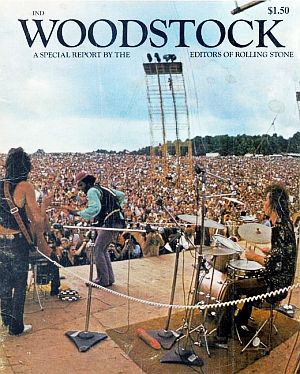
1969 "special report" from Rolling Stone magazine on Woodstock with cover photo of the Santana performance.
Woodstock Moment
Meanwhile, the “Santana moment” back at the Woodstock festival of August 1969, might now feel like ancient history and something that has receded into the musical ether.
Yet at that time and place in 1969 it was a transforming sound and performance; one that was new and exciting, innovative and liberating. It gave its listeners a new and uplifting experience. And it sent an unknown but rising group of musicians on their way, opening the doors to fifty more years of new music and experimentation across a diversity of Latin rock, African, and jazz-fusion genres. As the Rock and Roll Hall of Fame put in 1998: “Santana’s fusion of jazz, rock and Latin influences built them a hugely successful and lasting reign in the world of rock.”
For profiles of other artists at this website who were involved with, or have work related to Woodstock, see for example: “Crosby, Stills & Nash,” “Joplin’s Shooting Star,” and “Joni’s Music.”
Thanks for visiting – and if you like what you find here, please make a donation to help support the research and writing at this website. Thank you. – Jack Doyle
|
Please Support Thank You |
____________________________________
Date Posted: 14 August 2019
Last Update: 29 April 2023
Comments to: jdoyle@pophistorydig.com
Article Citation:
Jack Doyle, “The Santana Sound: Woodstock 1969,”
PopHistoryDig.com, August 14, 2019.
____________________________________
Sources, Links & Additional Information
“Santana/Carlos Santana,” in Holly George-Warren and Patricia Romanowski (eds), The Rolling Stone Encyclopedia of Rock & Roll, Rolling Stone Press, New York, 3rd Edition, 2001, pp. 857-859.
Charles Perry, “The Sound of San Francisco,” in Anthony De Curtis and James Henke (eds), The Rolling Stone Illustrated History of Rock & Roll, Random House, New York, 1992, pp. 362-369.
“Carlos Santana Biography,” Santana.com.
“Biography: Santana Induction,” Rock and Roll Hall of Fame, 1998 (Members: Carlos Santana, Jose Chepito Areas, David Brown, Mike Carabello, Gregg Rolie, and Michael Shrieve).
“Santana (band),” Wikipedia.org.
“Carlos Santana,” Wikipedia.org.
James Sullivan, “Presenting Bill Graham / Rock Ringmaster Gets Top Billing in A&E Documentary,” SFgate.com / San Francisco Chronicle, July 13, 2002.
“Latin Music USA – Bridges; The Salsa Revolution,” PBS-TV, KQED, September 2010.
“Woodstock Remembered: Carlos Santana on the Spiritual Vibe of the Fest,” Rolling Stone.com, August 5, 2019.
Rob Tannenbaum, “Woodstock at 50: How Santana Hallucinated Through One of Woodstock’s Best Sets (His Own),” New York Times, August 6. 2019.
“Santana – Soul Sacrifice 1969 ‘Woodstock’, Live Video HQ,” YouTube.com.
“Santana Discography,” Wikipedia.org.
“Remembering Woodstock: Why the 1969 Festival Still Resonates; Woodstock Was More Than a Concert — It Was a Social, Political, Musical Event That Changed Our Culture (with video),” Rolling Stone.com, August 1, 2019.
George Varga, “Carlos Santana on Woodstock, Tijuana and His Vibrant New ‘Africa Speaks’ Album and Tour,” PacificSanDiego.com, June 19, 2019.
“Santana Tour” (first tour, 1969-1970), Wikipedia.org.
“Woodstock: Music from the Original Soundtrack and More,” Wikipedia.org.
_______________________________________
